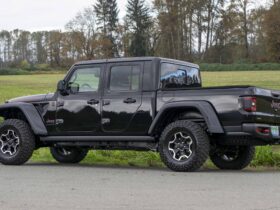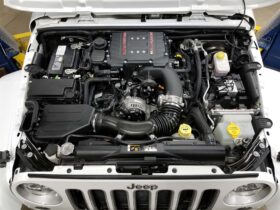The Jeep Wrangler is an iconic SUV known for its off-road capabilities, rugged style, and power. With the introduction of the 3.0-liter diesel engine, the Wrangler has gained a new level of performance. However, there are more options and always room for improvement, This article will explore the top performance upgrades you can make to your Jeep Wrangler 3.0 Diesel to enhance its power, acceleration, and overall performance.
Why Upgrade Your Jeep Wrangler 3.0 Diesel Performance?
Before diving into the upgrades, it’s essential to understand why upgrading your Jeep Wrangler 3.0 Diesel performance is crucial. Upgrades can help you achieve a smoother and more powerful ride while maximizing your vehicle’s potential. Some of the benefits of upgrading your Jeep Wrangler 3.0 Diesel performance include:
Improved power and acceleration
Enhanced fuel efficiency
Better towing and hauling capabilities
Improved throttle response
Improved handling and overall performance
Increased resale value
Top Performance Upgrades for Jeep Wrangler 3.0 Diesel
Here are the top upgrades you can make to your Jeep Wrangler 3.0 Diesel to improve its performance.
Cold Air Intake
A cold air intake system is one of the most popular upgrades for any vehicle. It replaces the stock air intake system with a more efficient one, allowing more air to flow into the engine. This results in improved performance and fuel efficiency. A cold air intake system is an easy and affordable upgrade that can provide noticeable gains in horsepower and torque.
Performance Exhaust System
A performance exhaust system is another upgrade that can significantly improve your Jeep Wrangler 3.0 Diesel’s performance. A performance exhaust system replaces the factory exhaust system with a larger, more free-flowing system that allows the engine to breathe better. The improved exhaust flow can result in better throttle response, increased power, and a more aggressive exhaust note.
Performance Tuner
A performance tuner is a device that plugs into your Jeep Wrangler 3.0 Diesel’s OBD-II port and modifies the engine’s computer settings. The tuner can adjust the engine’s air/fuel ratio, ignition timing, and fuel injection timing. This can result in increased horsepower and torque, as well as improved fuel efficiency. A tuner/programmer is a more expensive upgrade, but it can provide significant gains in performance.
Suspension Upgrades
A suspension upgrade can improve the handling and off-road capabilities of your Jeep Wrangler. A lift kit can provide additional ground clearance, allowing you to tackle more challenging terrain. A suspension upgrade can also improve the ride quality and reduce body roll during cornering.
Turbocharger Upgrade
A turbocharger upgrade is one of the more expensive upgrades, but it can provide significant gains in performance. A larger turbocharger can increase the amount of air flowing into the engine, which can result in improved horsepower and torque. A turbocharger upgrade can also improve the efficiency of the engine, resulting in better fuel economy.
Other significant upgrades are as follows:
Performance Exhaust System
A performance exhaust system is another popular upgrade that can improve the performance of your Jeep Wrangler. A high-flow exhaust system can increase the flow of exhaust gases, which can lead to better engine performance. A performance exhaust system can also give your Jeep Wrangler a more aggressive sound.
Intercooler Upgrade
An intercooler upgrade is another way to improve the performance of your Jeep Wrangler. An intercooler is a device that cools the air after it has been compressed by the turbocharger. This can result in denser air being delivered to the engine, which can lead to improved performance. An intercooler upgrade can also help to prevent engine damage caused by high temperatures.
Brake Upgrade
A brake upgrade can improve the stopping power of your Jeep Wrangler. Upgrading the brake pads, rotors, and calipers can result in better braking performance, especially during off-road driving. A brake upgrade can also reduce brake fade and increase the lifespan of the brake components.
Differential Upgrade
A differential upgrade can improve the traction and off-road capabilities of your Jeep Wrangler. Upgrading to a locking differential can ensure that both wheels on an axle receive equal power, which can result in improved traction in off-road situations. This can be especially useful in situations where one wheel may be slipping, such as when rock crawling.
Nitrous Oxide Injection
Nitrous oxide injection is a performance upgrade that can provide a significant increase in horsepower and torque. It works by introducing nitrous oxide into the engine, which provides a significant boost in power. However, this is a more advanced upgrade that should only be done by experienced professionals.
Upgraded Fuel Injectors
Upgrading to larger fuel injectors can help to improve the performance of your Jeep Wrangler. Larger fuel injectors can provide more fuel to the engine, which can result in increased horsepower and torque. This can also be useful when adding other performance upgrades, such as a turbocharger or supercharger.
Supercharger Upgrade
A supercharger upgrade is another way to increase the power output of your Jeep Wrangler. A supercharger works by compressing the air going into the engine, which can result in significant gains in horsepower and torque. However, this is a more expensive upgrade that should only be done by experienced professionals.
High-Performance Spark Plugs
Upgrading to high-performance spark plugs can improve the ignition process, resulting in improved engine performance. High-performance spark plugs can provide a hotter spark, which can lead to better fuel combustion and increased horsepower and torque. This is an easy and affordable upgrade that can provide noticeable gains in performance.
Performance Camshaft
A performance camshaft can be used to improve the power output of your Jeep Wrangler. A performance camshaft can increase the duration and lift of the valves, which can result in increased airflow and improved engine performance. However, this is a more advanced upgrade that should only be done by experienced professionals.
Upgraded Clutch
An upgraded clutch can be useful if you frequently take your Jeep Wrangler off-road. A heavy-duty clutch can provide better engagement and offer a stronger hold, which can prevent slippage during off-road driving. This can result in improved traction and better off-road capabilities.
Throttle Body Upgrade
Upgrading to a larger throttle body can help to improve the performance of your Jeep Wrangler. A larger throttle body can allow more air to flow into the engine, which can result in increased horsepower and torque. This is an easy and affordable upgrade that can provide noticeable gains in performance.
Conclusion
The Jeep Wrangler 3.0 diesel is a capable and powerful vehicle, but there is always room for improvement. By upgrading various components, such as the air intake, exhaust, tuner, and suspension, you can significantly improve the performance and off-road capabilities of Jeep Wranglers.
However, it is important to keep in mind that some upgrades and features may require more advanced skills and experience, so it is always best to consult with a professional before making any modifications.
FAQs
Is the Jeep 3.0 diesel a good engine?
Yes, the Jeep 3.0 diesel engine is a reliable and efficient engine. It has received positive reviews from Jeep enthusiasts and automotive experts. The engine is known for its impressive fuel economy, smooth performance, and low-end torque.
How much horsepower does a Jeep Wrangler 3.6 Diesel have?
The Jeep Wrangler 3.0 Turbo Diesel engine produces 260 horsepower and 442 lb-ft of torque. This engine provides ample power for towing, off-roading, and everyday driving.
How much can a Jeep 3.6 L V6 Turbo Diesel tow?
The Jeep 3.6 L V6 Turbo Diesel engine can tow up to 3,500 pounds when properly equipped. This towing capacity is perfect for towing small trailers, boats, and other lightweight cargo.
How much horsepower and torque does a Jeep 3.0 diesel have?
The Jeep 3.0 diesel engine produces 260 horsepower and 442 lb-ft of torque. This engine is powerful and efficient, making it a great choice for off-road adventures and everyday driving. With this engine, you can expect smooth and reliable performance, no matter where your journey takes you
Is it worth upgrading my Jeep Wrangler 3.0 Diesel’s performance?
Yes, upgrading your Jeep Wrangler 3.0 Diesel’s performance can be worth it if you want to enhance your vehicle’s power, acceleration, fuel efficiency, handling, and overall performance. These upgrades can also increase and protect the resale value of your vehicle.
How much does it cost to upgrade a Jeep Wrangler 3.0 Diesel’s performance?
The cost of upgrading your Jeep Wrangler 3.0 Diesel’s performance can vary depending on the type of upgrade you choose. Cold air intakes and performance exhaust systems can cost between $300-$1000, while suspension upgrades can cost between $500-$3000. Performance tuners and turbocharger upgrades can be more expensive, ranging from $500-$3000 or more.
Can I install performance upgrades on my own?
Some performance upgrades like cold air intakes and exhaust systems can be installed on your own, while others like suspension upgrades, performance tuners, and turbocharger upgrades require professional installation services. It’s essential to read the instructions carefully before attempting any installation yourself and seek professional help if you’re not confident in your abilities.
Will upgrading my Jeep Wrangler 3.0 Diesel’s performance affect its warranty?
Some upgrades like cold air intakes and exhaust systems may not affect your vehicle’s warranty, but more advanced upgrades like performance tuners and turbocharger upgrades may void your warranty. It’s important to check with your dealer or manufacturer before making any upgrades to ensure you don’t void your warranty.
How much power can I expect to gain from upgrading my Jeep Wrangler 3.0 Diesel’s performance?
The amount of power you can gain from upgrading your Jeep Wrangler 3.0 Diesel’s performance depends on the type of upgrade you choose. Cold air intakes and exhaust systems can increase horsepower by 5-15 hp, while performance tuners and turbocharger upgrades can add 50-200 hp or more, depending on the vehicle and upgrade.












Leave a Reply